Graziani F. (editor) Computational Methods in Transport
Подождите немного. Документ загружается.

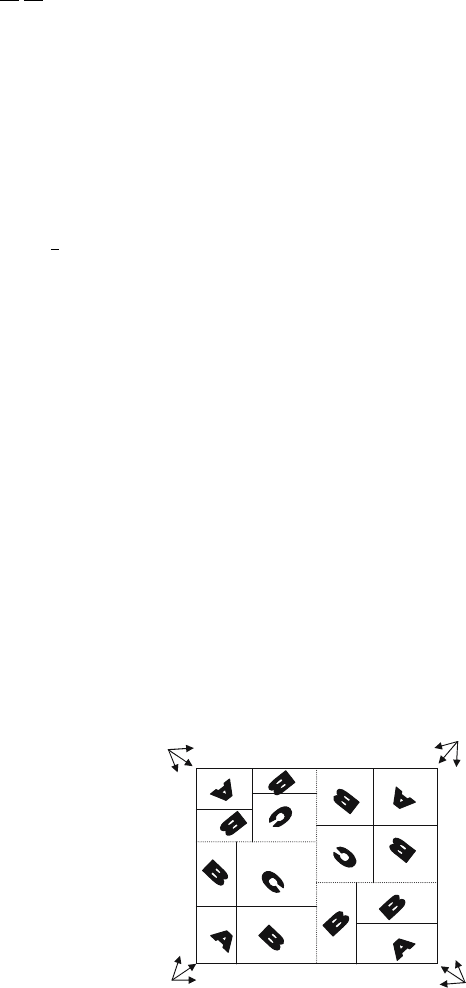
502 C.J. Clouse
1
v
g
∂
∂t
Ψ
g
m
+
ˆ
Ω •
→
∇
Ψ
g
m
+ σ
g
t
Ψ
g
m
=
l
(2l +1)P
l
g
σ
lg g
φ
g
l
+ υσ
g
f
φ + q (4)
where
Ψ
g
m
= angular flux for energy group g and angle m,
P
l
= Legendre polynomial term l,
σ
g
t
= total cross section for energy group g,
σ
lg g
=thel
th
component of a Legendre polynomial expansion of the dif-
ferential scattering cross section from group g
to group g,
v
g
= the neutron velocity for group g.
φ
g
l
=
1
2
m
P
l
(µ)Ψ
g
m
where m is the discrete angular index.
υσ
g
f
ϕ = represents the production of the scalar flux into group g,andq
represents a possible, externally driven source term.
AMTRAN can solve (4) as either a fixed source calculation (where q is
non-zero) or the usual k eigenvalue calculation, where k is a multiplier on
the fission source term, or α eigenvalue calculation where the time dependent
term is included in (4) and the time dependence is modeled as e
αt
. Equation
(4) is solved through standard source iteration and angular sweeps in which
the source terms on the right hand side of (4) are evaluated using the pre-
vious iterates values for the fluxes. Then, with the value of S determined,
inversion of the sweeping term on the left hand side of (4) is accomplished
by sweeping through the mesh in the direction of neutron flow; one sweep
for each unique combination of direction and energy group. This downwind
sweeping is complicated by block decomposition on a domain decomposed
mesh in which different domains reside on different processors. In order to
avoid idling processors, AMTRAN’s default domain decomposition is limited
to 8 domains (4 domains in 2D). By ensuring that each domain includes one
of the corners of the problem, all domains can immediately begin sweeping.
Figure 2 illustrates a simple 2D example assuming four spatial domains and
Fig. 2. Dashed lines indicate domain (and block) boundaries. Solid lines indicate
block boundaries
Parallel Deterministic Neutron Transport with AMR 503
12 angles. Each block designated “A” can be swept immediately by any one of
the three angles that originate from its corner. After any “A” block is swept,
its neighboring “B” blocks would have sufficient boundary information to
begin their sweep, followed by the “C” blocks, etc. A domain continues to
sweep blocks until no more blocks can be swept without receiving information
from neighboring domains, at which point it sends out all of its downwind
boundary information to the necessary neighboring domains and waits to re-
ceive upwind boundary information from any domains. AMTRAN assigns an
estimated weight to each zone in the generator mesh based on the mean free
path in that zone. This allows AMTRAN to estimate where to place domain
boundaries such that each domain has roughly equal weight and, therefore,
will have roughly equivalent zone counts after the AMR blocks are made. If
each domain has roughly equivalent zone counts, then each will finish their
sweeps at about the same time, pass information to and receive information
from neighboring domains, and continue sweeping with little or no idle time.
If there are reflecting boundaries in the problem, then the corners that lie on
reflecting boundaries will begin their sweeps with “old” boundary information
from the previous iteration. (Our definition of the term “iteration” is com-
parable to the standard textbook definition of an “outer iteration”, which
implies all angles have been swept through the entire mesh.) This causes
some degradation in the rate of convergence, but the fractional increase in
the number of iterations it takes to converge is usually substantially smaller
than the relative speedup achieved by simultaneously beginning sweeps from
all corners. For example, in 3D critical sphere calculations with one reflection
plane, the number of iterations required to achieve convergence is about 20%
more than the number of iterations required by ordering the sweeps such
that reflecting boundaries are not swept until incoming sweep information is
received, but the calculation will run roughly twice as slow by ordering the
sweeps since half the processors will be idle at any given time. Because eight
spatial domains (four in 2D) can be very limiting when attempting to scale up
to thousands of processors, recent work in AMTRAN has focused on efficient
use of processors with more than eight spatial domains. Basically, the idea for
achieving high efficiency is through the use of domain overloading techniques.
We have created the construct of a domain master which represents a unique
collection of domains that may or may not be located contiguously in space.
Domains are assigned to domain masters in such a way as to keep the domain
master busy as much of the time as possible. Systematic algorithms have been
worked out that asymptotically approach 100% theoretical efficiency as the
number of domains per domain master is increased. The difference between
theoretical and actual efficiency is dependent on how well the code is able
to produce domains that are roughly equal in computational work, since the
algorithm assumes equal weight domains. Details of the algorithm have been
presented at an international conference [10], and will be outlined in a journal
article in the near future.
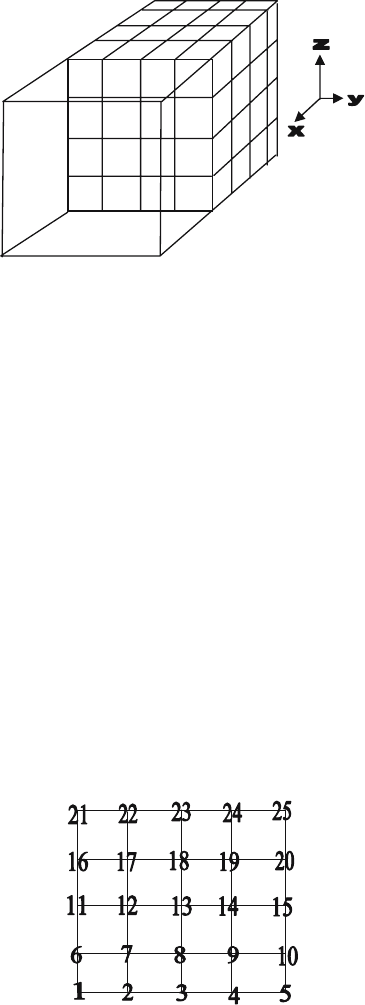
504 C.J. Clouse
Fig. 3. A single zone from a coarse block that borders a finer block along it’s x-face
2.3 Block Interfaces
As the sweeps proceed from block to block, three scenarios can occur at block
boundaries: (1) no change in zoning, (2) go from a coarser mesh to a finer
mesh, (3) go from a finer mesh to a coarser mesh. The first scenario obvi-
ously requires no special treatment. The second scenario can be dealt with
in a straight forward fashion through bilinear interpolation of the coarse grid
fluxes onto the fine mesh. This is consistent with the linear finite element
representation of the fluxes at the nodes. Unfortunately, the finite element
representation of the fluxes at the nodes does not provide an obvious unique
solution to the third scenario, which is illustrated in Fig. 3. Over time, three
different methods evolved in the code for treating scenario 3. The original
method, referred to as the pseudo-source method, is constrained by two cri-
teria: fluxes of nodes at the same physical location on two different mesh
should have the same value and flux must be conserved across the interface.
To satisfy the first criterion, we require that fluxes at nodes 1, 5, 21 and 25
in Fig. 4 have the same value on the coarse and fine blocks. If we integrate
(1) over a zone and focus on just the streaming term for the specific example
Fig. 4. Y-z interface of coarse to fine zone. Fine zone nodes are numbered 1 to 25.
Coarse zone nodes are nodes 1, 5, 21 and 25

Parallel Deterministic Neutron Transport with AMR 505
shown in Figs. 3 and 4 with neutrons traveling in the +x direction, then the
flux leaving the fine zones overlapping the coarse zone can be written as,
25
i=1
y
0
+∆y
y
0
z
0
+∆z
z
0
w
yi
w
zi
Ψ
i
dz dy (5a)
where, w
yi
and w
zi
are the y and z components of the linear finite element
weight functions at node 1, defined as
w
yi
=1−
(y
i
−y)
dyf
for y
i−1
≥ y ≥ y
i
,w
zi
=1−
(z
i
−z)
dzf
for z
i−1
≥ z ≥ z
i
w
yi
=1−
(y−y
i
)
dyf
for y
i+1
≥ y ≥ y
i
,w
zi
=1−
(z−z
i
)
dzf
for z
i+1
≥ z ≥ z
i
w
yi
=0 and,w
yi
= 0 elsewhere,
and dyf = dzf =
1
/
4
∆y where ∆y = ∆z is the zone size on the coarse grid
and the coordinates of node 1 are given by (y
0
,z
0
). Likewise, the flux entering
the coarse zone can be expressed as
i=1,5,21,25
y
0
+∆y
y
0
z
0
+∆z
z
0
w
c
yi
w
c
zi
Ψ
i
dz dy (5b)
where, w
c
yi
and w
c
zi
are the y and z components of the linear finite element
weight functions on the coarse zone at node 1, defined as
w
c
yi
=1−
(y
i
− y)
∆y
for y
i
≥ y, w
c
zi
=1−
(z
i
− z)
∆z
for z
i
≥ z,
w
c
yi
=1−
(y − y
i
)
∆y
for y ≥ y
i
,w
c
zi
=1−
(z − z
i
)
∆z
for z ≥ z
i
.
At the time boundary information is received, the difference between (5a)
and (5b) is calculated and stored as an additional zone centered source term
that is included in the solution of (4) and, thus, from the perspective of nodes
downwind from the boundary, the total flux crossing from the fine mesh to
the coarse mesh has been accounted for through the inclusion of an additional
source term, which we will refer to as the pseudo-source term. In a similar
fashion, the difference between the coarse and fine mesh for the second term
on the left hand side of (4), the absorption term, is also accumulated into
the pseudo-source term. The second method is referred to as the marching
method and is illustrated in Fig. 5. In this method, the value of the most
downwind node (node A in Fig. 5) is copied to the corresponding physical
node on the neighboring coarse grid (node F in Fig. 5). The value of node G
is then simply determined by flux conservation across the interface between
nodes F and G. The value of node H is then determined by flux conservation
across the interface between node G and H, etc.
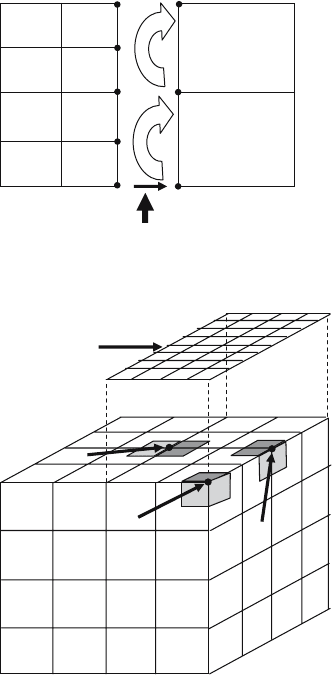
506 C.J. Clouse
Direction of neutron flow
A
F
B
C
D
E
G
H
Fig. 5. Marching Method
Node C
Node B
Node A
Block I
Overlapping face of
Block II
Fig. 6. Area Weighting Method
The third method is referred to as the area weighting method and is
illustrated with a 3D example in Fig. 6. In our example, we have a coarse
block (block I) partially overlapped by a fine block (block II) on the top face.
For neutrons incident on the upper right front corner, node C would not only
receive a flux contribution from block II (indicated by the shaded area) but
also from two other blocks that overlap the two faces that are orthogonal to
the shaded face. The total contribution would be the area weighted sum of
the three incident faces. A corner node, like node C, can be shared by up to
8 blocks (in 3D), each of which may have a different flux value for that node.
Only in the case where all blocks sharing a node are at the same AMR level
are we guaranteed that all blocks see the same physical value. In the case of
node A, the lightly shaded area would contribute to the area weighted nodal
flux, but if node A were located on the left edge of block I, then the lightly
Parallel Deterministic Neutron Transport with AMR 507
shaded area would either be located on a separate block or, in the case of block
I lying on the left edge of the problem, there would be no neighboring block.
In either case, the lightly shaded area would not contribute to node A’s value.
Likewise, if the direction of neutron flow were from back to front, only the
shaded face, representing block II’s contribution, would contribute to node
C’s value. Thus, one can see that the area and number of faces contributing
to a nodal flux value is dependent on the direction of neutron flow. Method 1
is difficult to implement in time-dependent problems and method 2 is prone
to instabilities. Thus, the default method used in AMTRAN is method 3.
2.4 Energy Group Parallelism
Distributed memory parallelism (i.e. the number of MPI processes spawned)
is equal to 8 (or 4 in 2D) x the number of energy groups per process. If
the number of processes is not evenly divisible by 8 (or 4 in 2D) then the
number of energy groups on a processor will vary by processor. In the case of
maximum parallelization, the user runs with one energy group per process.
Typically, in serial Sn codes, energy groups are swept sequentially from high-
est to lowest where the source term is updated after each energy group sweep
so that effects from higher groups are immediately included in the lower
group sweeps, thus providing Gauss-Seidel like convergence on the iteration.
Therefore, in the case of no upscatter, the solution would converge after a
single iteration of all groups. In the case of maximum parallelization, which is
frequently the case in a typical AMTRAN calculation, all energy groups are
being solved simultaneously, using source terms calculated from the previous
iterate fluxes and, therefore, the iterative technique is Jacobi-like rather than
Gauss-Seidel. One might expect a Jacobi solution to take more iterations to
converge than Gauss-Seidel however, in practice, what we observed for prob-
lems dominated by fission, and thus have large upscatter components, there
appears to be a break-even point at about 16 energy groups where, for prob-
lems with fewer than 16 energy groups, a Jacobi solution converges in fewer
iterations and with more than 16 energy groups, a Gauss-Seidel solution con-
verges in fewer iterations. The difference was not large, however, varying by
about +/−20% from 6 to 24 energy groups.
In AMTRAN, each process calculates it’s energy group(s) contribution
to the source term of each energy group in the problem. At this point, two
different methods can be employed for communicating the results to the other
processes. The first method is a tree-summing algorithm illustrated in Fig. 5
for a 4 group calculation with one energy group per process.
Many vendor implementations of MPI
−
Allreduce implement essentially
the same algorithm, however, we have seen MPI
−
Allreduce performance on
some machines to be substantially worse than our implementation of the
above algorithm and, therefore, we do not rely on the MPI
−
Allreduce call for
the summing of the sources since it can be a significant fraction of the run
time of a calculation.
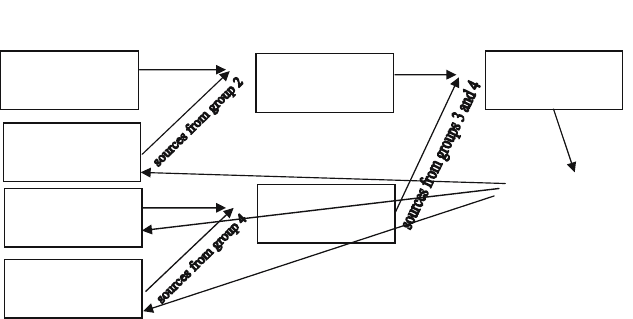
508 C.J. Clouse
Process 1
Ener
gy g
rou
p
1
Process 2
Ener
gy g
rou
p
2
Process 3
Ener
gy g
rou
p
3
Process 4
Ener
gy g
rou
p
4
Process 1
Process 3
Sum Sources
Process 1
Sum Sources
Broadcast results
Fig. 7. Tree-summing algorithm
A second method takes advantage of the fact that a process only needs to
know what the source contributions are to it’s energy group(s). Thus, after
a process computes the contribution of its energy group(s) to all the oth-
ers, it sends individual messages to each process containing the contribution
to that process’ energy group(s). This is illustrated in Fig. 8. The method
illustrated in Fig. 7 requires 3(N-1) communications while that illustrated
in Fig. 8 requires N(N-1) communications, where N is the number of MPI
processes per domain. The messages in the second method, though, are much
smaller and less synchronized than those in the first method and, as a result,
provide about a factor of 2 reduction in wall clock time for a 16 energy group
calculation on the IBM ASCI Pacific Blue SP-2 machine at LLNL.
3 Numerical Results
As a simple numerical demonstration of the effectiveness of spatial AMR, the
two-dimensional rod test case, as defined in [4], will be used. This problem
consists of a cylindrical rod of
235
U surrounded by vacuum with a density
that decreases linearly from 66.71 g/cm
3
at the center plane to 20.09 g/cm
3
at the ends. All problems were run on LLNL’s Thunder machine, which is a
1024 node (four processors per node), 1.4 GHz Itanium machine. Aussourd
4
specifies the finest level zoning to be 1 mm and gives results for up to 8 levels
of AMR, but states that efficiency gains beyond 3 levels are negligible and
tend to degrade accuracy. In fact, since the difference in density between the
peak value and the ends is only a little more than a factor of three and the
neutron mean free path varies linearly with the density, allowing more than
three levels violates AMTRAN’s default zoning criteria, since three levels
of refinement already represents a factor of four difference in zone size for
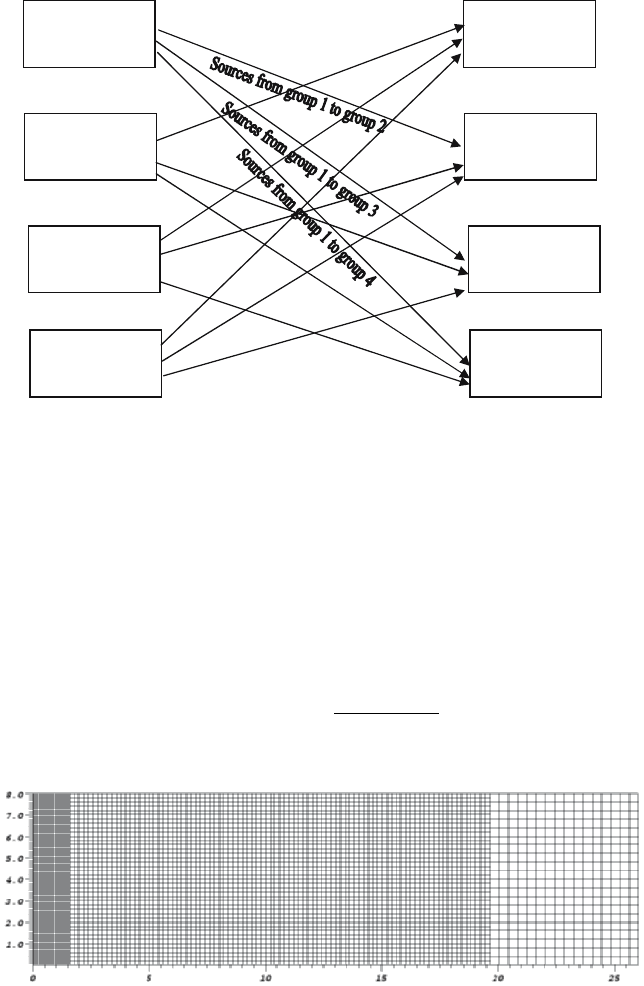
Parallel Deterministic Neutron Transport with AMR 509
Process 1
Energy group 1
Process 2
Energy group 2
Process 3
Energy group 3
Process 4
Energy group 4
Process 1
Energy group 1
Process 2
Energy group 2
Process 3
Energy group 3
Process 4
Energy group 4
Fig. 8. Arrows for process 1 are labeled. Arrows for other processes would be
labeled in an analogous fashion
each direction. Figure 9 shows the zoning used by AMTRAN with three
levels of refinement. Table 1 shows the results of several serial variations of
the calculations relative to a serial baseline calculation consisting of a single
block, uniformly zoned with 1 mm zoning. The k
eff
of the baseline calculation
was 1.98480, which differs slightly from [4]. This isn’t surprising since the
nuclear database and energy group resolution were not specified, so a direct
comparison could not be made. The relative error in Table 1 is defined as:
Error = abs
1 −
1 − k
ef f
1 − k
baseline
ef f
(6)
Z (in cm)
R (in cm)
Fig. 9.

510 C.J. Clouse
Table 1.
Mesh Relative Relative compute Number of
Error time zones
Uniform, single block
(baseline calculation) 0 1 20800
Uniform, multi-block 0 0.95 20800
3 level AMR 2.0e-5 0.20 5200
Ref. 4 with 3 level AMR 4.1e-5 0.30 5760
and the relative compute time is just the ratio of the time for the calculation
relative to the baseline calculation:
Compute time =
time
time
baseline
(7)
The major difference between Aussourd’s [4] AMR method and our ap-
plication is our block based approach versus his tree based hierarchy. As he
points out, the advantage to a block based approach is it is more amenable
to spatial parallelism, but is less efficient in reducing zone counts. A tree
based algorithm is better able to capture irregularly shaped gradients. Our
experience, however, has been that calculations generally run more efficiently
with liberal settings for the boxing efficiency; i.e. it is better to minimize the
number of blocks at the expense of running with more total zones. This as-
sumes, of course, that the difference in zone count is not too large; generally
no more than about 20%. If the difference is significantly more that 20%, it
is probably worthwhile to increase the boxing efficiency.
Aussourd [4] reports roughly 40% overhead associated with the AMR logic
for this test problem. As can be seen from Table 1, we observe little, if any,
overhead. In fact, the multi-block logic, which is the major cost associated
with the AMR overhead of our block based approach, actually experiences a
5% reduction in run time for a uniform calculation relative to a single block
uniform calculation. This is most likely do to improved cache performance of
the multi-block approach since, if a block is small enough for all the unknowns
to fit into cache, the sweeps can be performed without cache swapping. We
have seen this effect in the past and, in fact, added an input variable which
allows users control over the maximum size of a block so calculations can
be tuned for different architectures. This super-linear speedup is also seen in
the three level AMR calculation, which runs 5 times faster than the baseline
calculation despite the fact that the zone count is only reduced by a factor
of 4. It should be noted, though, that this particular test problem is ideally
suited for a block based AMR approach, since the gradients are planar.
Figure 10 shows the relative speed improvement for the rod test problem
as a function of processor count. All points were run with the three level AMR
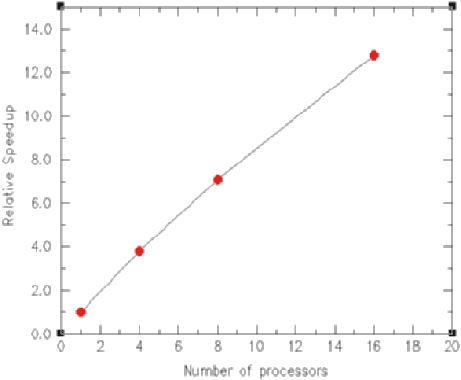
Parallel Deterministic Neutron Transport with AMR 511
Fig. 10. Relative speedup as a function of the number of processors for the rod
test problem (fixed problem size)
version of the problem, giving a total of 5200 zones with 16 energy groups and
S10 quadrature. The 4, 8 and 16 processor runs used 4 spatial domains. The 8
processor run has two processors assigned per domain, and, therefore, would
be running with 8 energy groups per processor. The 16 processor run has 4
processors assigned per domain, thus giving 4 energy groups per processor.
Since there are two reflecting planes in this problem (the axis and z =0),
the domain decomposed problems take more iterations (∼20% increase) to
converge than does the serial calculation, so the timings have been normal-
ized to the iteration count of the serial calculation. As can be seen from the
plot, we achieve about a 12.8X speedup with 16 processors, giving an overall
parallel efficiency of 80%. The small problem size limits the degree of par-
allelism we can employ for this particular test case (the 16 processor run
completed 116 iterations in about 7 seconds). Two dimensional calculations
are commonly run that exceed 50,000 zones with 32 or more energy groups.
A large three dimensional calculation can have several million zones. These
kinds of calculations require hundreds to thousands of processors.
4 Future Work
Much of our recent effort has been focused on the ability to refine in direction.
Problems such as the neutron interrogation of a cargo container, mentioned
in Sect. 1, not only require spatial AMR because of the large problem dimen-
sions, but one is generally only interested in a narrow region of directional
phase space; basically the cone of angles, originating from a 14 MeV source,
